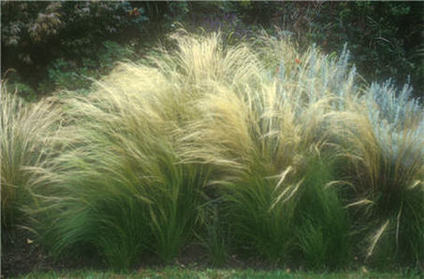
tel: 512-280-1192 Friday, March 30, 2012
Nursery Notes: Ground Up Bagged Goods Sale: BUY 2, GET
1 FREE! Hardwood mulch, humus compost, Texas planting mix,
sustainable mix, and a rose-azalea mix. This special is for April -
this weekend included.

Zilker Garden Festival this Sat and Sun, 10 a.m. - 5 p.m.
Music, events for kids, flowers... and Chris Winslow with the It's
About Thyme stand by the main entrance. Please stop by to say
hello. Some interesting talks are happening throughout the week-
end. Highlights include:
12:30 pm on Saturday, Linda Lehmusvirta on 'Psycho Lighting,'
where shade in a garden 'is offset with searing blasts of
sunlight.' Followed at 1:30 pm by Jeff Pavlat on Cacti & Succulents.
On Sunday at 11:30 a.m., Wizzie Brown talks about Landscape
Insects, the Good and the Bad, and at 1:30 the brilliant local
herbalist Ellen Zimmerman will talk about roses.
______________________________________________________
Central Texas Gardener (KLRU-TV): Tips on raising chickens
with Michelle Hernandez from the Austin Funky Chicken Coop tour.
Daphne Richards notes when to fertilize plants and lawn. Sat. noon
or 4 p.m. or Sun: 9 a.m. www.klru.org/ctg/
_____________________________________________________
Rain Causes Crane Fly Population Boom A year of drought
followed this year's 13-16 inches of rain has created a perfect
conditions for certain insects, including the 'giant mosquitos'
known officially as crane flies. A KUT report by Nathan Bernier:
http://kut.org/2012/03/rain-causes-crane-fly-population-boom/

Mexican Feather Grass - 'moves gracefully with the slightest breeze'
The Garden in April
by Chris Winslow
April arrives quite suddenly on Sunday. Time to get busy gardeners!
1. Spring vegetable gardening Plant those warm season crops. This
list includes beans, black-eyed peas, okra, squash, cantaloupe,
tomatoes, peppers, cucumbers, watermelon, corn, and eggplant. There
is still time to plant cooler season crops like lettuce, radishes, and carrots.
2. Fertilize your garden Do this organically with compost. Other
sources of nutrition are dried fish flakes and organic fertilizers form-
ulated for garden use. You can also use liquid fertilizers, such as fish
emulsion and seaweed extracts.
3. Control weeds Keep them down with mulch and by weeding a
little bit every day.
4. Plant spring annuals This is the perfect time. Work some compost
into your flower beds and you will give these new plants just the
food they need to flower through the summer. Here are some ideas:
begonias, zinnias, marigolds, petunias, coleus, periwinkle, cosmos,
larkspur, portulaca, and purslane.
5. Plant perennials Choose some of your favorites from the exten-
sive lists available, or visit your neighborhood nursery and browse.
Look for the many varieties of drought tolerant and showy lantanas
and salvias. Also blackfoot daisies, skullcaps, purple coneflowers,
black-eyed Susan, plumbagos, columbines, rockrose, ruella, and
verbena.
6. Ornamental grasses Native varieties are best due to their heat
and drought tolerance. My favorites are big muhley, coastal muhley
and the maiden grasses. For a short grass in a very dry place, you
might like Mexican feather grass. It is blond-colored, reaches 1.5'
in height, and makes a beautiful accent plant that moves so grace-
fully with the slightest breeze.
7. Fertilize lawn Use a slow release organic fertilizer. A 3-1-2 ratio
is best. Allow 10 pounds of fertilizer for every 1,000 square feet of
lawn. Mowing height should be 2.5 inches for St. Augustine grass
and 2 inches for Bermuda and zoysia. I like to return the grass clipp-
ings to the turf. These clippings act as a mulch and help to reduce
weeds. Water infrequently and deeply to encourage a deep root
system. This practice will train your lawn grass to be more drought
tolerant and help to conserve water.
8. Fertilize shrubs, trees Mulch with a compost-mulch blend to
provide nutrients and conserve water. Deep, infrequent watering of
shrubs and trees will encourage deep, drought tolerant root systems.
Remember to seal pruning cuts on oak trees. It might save them from
oak wilt.
Happy Gardening everyone. See you at Zilker!
 Visit the website: www.itsaboutthyme.com
Visit the website: www.itsaboutthyme.com